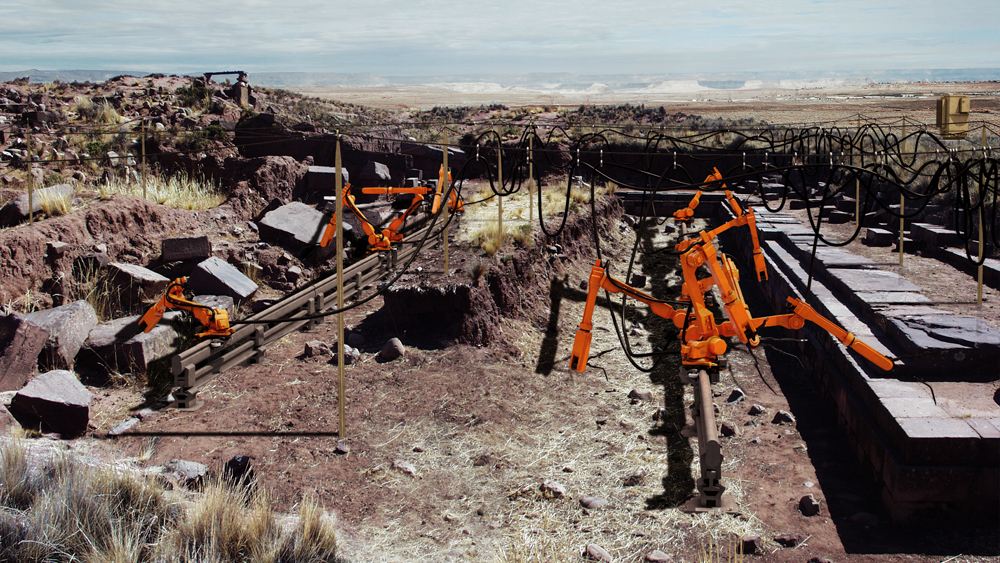Counter Productive
A collaboration between Geoff Manaugh and John Becker

In March2011,the U.S. Environmental Protection Agency debuted a robotic arm called Tox21, to be used in testing the safety of nearly 10,000 industrial chemicals. This semi-autonomous robot is not only speeding up critical laboratory analyses, "the EPA explains- as it works 24 hours a day, 7 days a week- but it is also helping to eliminate "the controversial use of animals in product safety testing." Tox21's resulting "chemical library," as the EPA describes it, will thus provide an encyclopedic overview of chemical safety in the 21st century, and it will be achieved by way of a device that more closely resembles something from an automobile assembly plant than anything currently associated with medical research.
But as we will see below the field of medical robots is on the rise.
In 2009, the California-based firm Intuitive Surgical updated its Da Vinci robotic system. The new and improved, 1.75 million Da Vinci now "combines superior 3D high definition vision, patented EndoWrist instruments and Intuitive motion to allow for unparalleled precision, visualization, dexterity and control," the firm explains. "The end result: a breakthrough in surgical capabilities that is changing the experience of surgery."
This is no exaggeration: today, patients undergoing complicated medical procedures-for everything from prostate cancer to colorectal surgery-will increasingly find themselves anesthetized not in the presence of human surgeons at all, but in the shadows of a robot, one able to perform a wide range of precise, highly delicate maneuvers. All of this will be remotely guided by experts, potentially hundreds of miles away as they study the procedure from afar using head-mounted screens.
Similarly, the Sofie surgical robot, designed by Dutch medical researcher Linda van den Bedem and unveiled in September 2010, became the first semi-autonomous surgical system to incorporate what is known as "force feedback," or real-time tactical feedback for human operators who control the robot via videogame-like joysticks. In other words, if the robot's scalpel hits a snag-or a bone-the remote controllers, far away, also feels it.
It is worth pointing out here that the earliest research and development of these robotic telesurgical systems was originally sponsored both by NASA and by DARPA (the Defense Advanced Research Projects Administration). The initial idea was that life-saving acts of surgery could be performed, even in violent or inhospitable environments, without the need for human doctors. These extreme environments could include both active war zones and even spaces disconnected form the earth's surface altogether, such as future Martian colonies or the International Space Station.
Should truly autonomous, artificially intelligent robot surgeons ever be developed, they could even be incorporated directly into the architecture of these future sites, whether they are remote military bases, scientific field camps, or even apartments and suburban homes. Indeed, any room can become an operating room. Surgery then becomes indistinguishable from other modern building services, not unlike HVAC or waste disposal; emergency medical treatment could literally be built into the walls around you.
Companies such as ABB and FANUC Robotics have long manufactured robotic systems for the complex assembly of other industrial products. Robotic car-assembly lines are only the most familiar examples of these. From arc welders and wall-mounted painting robots to highly mobile arms used in the transportation of heavy payloads, the variety of semi-autonomous systems already active on the world today is astonishing.
Like a future natural history museum, in which the skeletons on display are actually machines-and they are engaged in the assembly of everyday industrial objects-these robotic systems literally build the world of objects we are surrounded by. FANUC alone suggest that their robots can be used in "aerospace, automotive, consumer goods, food, metal fabrication, medical, pharmaceutical, solar panel, and many other industries." "Is a robot right for you?" FANUC asks.
Perhaps. But there is at least one field missing from FANUC's otherwise extensive list.

Archaeological research today increasingly occurs in landscapes of physical danger and political conflict. Whether it's the extraordinary Roman site of Leptis Magna-located in present day Libya and suspected, in the summer 2011, of having been repurposed as an active military base for Qaddafi loyalists-or it's in contemporary Israel, where historical excavations are often tainted by nationalist pursuits, archaeological research needs a way to function even amidst scenes of extreme instability.
For instance, sites of archaeological research can literally be fatal for human workers: these are sites too dangerous to be staffed on anything like a regular basis. The radioactive landscapes of Chernobyl, the Hanford Site in Washington State, and the nuclear facilities at Sellafield, in England, are only three of the most highly contaminated sites at which industrial archaeology must, nonetheless, be pursued. There is much to learn-historically and scientifically-from these locations, but the actual work of forensic excavation is either prohibitively expensive or unacceptably dangerous for human workers. This difficulty extends to places the human body cannot reach at all-such as deep-sea shipwrecks-and to scenarios in which human precision simply is not accurate enough for what a site requires.
We thus propose an autonomous archeological field unit-or robotic excavation system-to be deployed in these and other extreme landscapes. The design of the system, including its instrumentation and motion controls, comes directly from the emerging fields of medical and construction robotics, as described above. Each robot arm can thus hold exceptionally fine tools of precision research-often modeled after dental equipment, including calipers, brushes, suction systems, picks, and piezoelectric scalars-as they painstakingly scrape down into the dirt and rocks, millimeter by millimeter.
Robust archaeological site grids-here, mounted with multi axis, geologically sensitive, force-feedback excavation arms-allow the system to slide freely over the excavation pit, which can potentially now expand to several acres in size. Until full autonomy for these systems can be realized, each arm will be operated individually by researchers living off-site, in the safety of a university lab or private research compound. Supervisory archaeologists who have not left their home or office in ages can thus watch and directly control an army of archaeological robots working on the other side of the world. High-definition cameras, lasers-scanning total stations, and ground-penetrating radar modules mounted on the robot arms, as well as on the rim of the project site, will allow for extraordinary spatial detail and contextual legibility.
A distributed research program, modeled after SETI@Home, could even someday be developed: this would allow for nearly anyone with an internet connection to perform archaeological research from their home or office, crowd sourcing the excavation process.
More importantly, these systems could be used in places human beings cannot survive: in heavily polluted or radioactive environments, including failed reactors; on the fringes of active war zones, when resupplying inhabited field camps becomes too difficult" underwater, offwater, offworld (for instance, the Apollo lunar landing site), and even far beneath the surface of the earth. These robots could also be installed pre-emptively inside buildings and cities on the verge of abandonment and collapse. After all, who will excavate the dead cities of the 22nd century? Robotic excavating arms could be added well in advance of future changes, dotting the contemporary cityscape like street-lights or highly patient statuary, awaiting their moment to dig, scrape, test, and forensically analyze lost urban worlds.
In the end, these robotic autopsies of the earth-digging down into the accumulated surfaces within which human history is laminated-could produce something as basic as fragments of shattered pottery, the weapons of a classical battleground, or the hull of an ancient ship. Or they could reveal something much more intricate: an entire buried city, like Pompeii or Brooklyn 45,000 A.D.
Somewhere, silhouetted on a windswept plain, surrounded by radiation warning signs, the sky above it red with encroaching storms, a crooked robotic arm will work away, assembling nothing amidst those future ruins but exposing a history that distant archaeologists would otherwise have lost forever.


Project can be found in Evolo Issue 05 Architecture Xenoculture.
Guest Editors: Juan Azulay (Matter Management), Benjamin Rice
(Pages 128-135)




